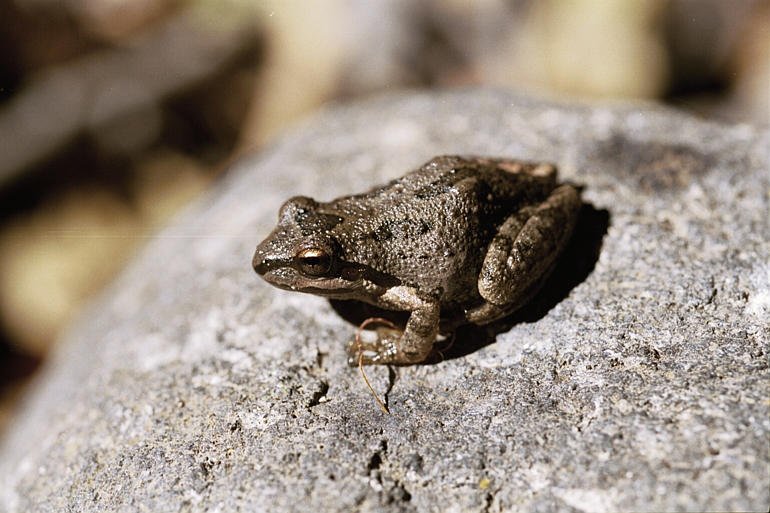Notes from the Field: Frogs
Pacific treefrog: Pierre Fidenci
The Heralds of Spring
As sure a sign of spring as the increase in frequency and intensity of birdsong is the seemingly sudden surge of frog calls. Both birdsong and “frog song” are offered mostly by males for communication, to attract and court females and to ward off rivals or defend turf. Whether welcomed as a joyful chorus or disparaged as a persistent cacophony, springtime frog song reminds us of the ubiquity of these otherwise shy amphibians, even here in the high desert of Central Oregon.
Frogs are also excellent indicators of environmental quality due to their vulnerability to pesticides and toxins in aquatic ecosystems as well as their sensitivity to dewatered streams and wetlands.
From Tadpole to frog
American bullfrog: Wikimedia Commons
Frogs emerge from hibernating in burrows, crevices, or pond sediment when the temperatures increase in the spring. Courtship is followed by mating, in which the male holds the larger female from behind around the waist in a position called amplexus, which provides for fertilizing the eggs externally as they are released into the water.
Even largely terrestrial amphibians produce moisture-dependent, unshelled eggs, and frogs can produce hundreds or thousands in a single season. Gelatinous clumps or strands of egg masses become apparent in the flat or slack water of many area ponds and streams, transparent except for the developing embryo in the middle of each little egg.
Tadpoles hatch from the eggs after 3-4 weeks. Not surprisingly, early mortality is high, illustrating what population ecologists describe as Type III survivorship, where very few individuals will live to maturity. Added to that struggle is the remarkable developmental transformation that we refer to as metamorphosis, from the Greek for next or later form.
The familiar morphological transformation from tadpole to frog, as the tail is completely absorbed and limbs emerge, is accompanied by equally astonishing internal anatomical and physiological transformations. The respiratory system is remade for breathing air, and the digestive system is remodeled to accommodate a switch from herbivory to carnivory. Perhaps the advantage to animals that undergo metamorphosis is niche separation between young and adult, reducing competition and maximally exploiting different resources.
Pacific treefrog: Wikimedia Commons
The Frogs of Oregon
There are a dozen species of frogs and toads native to Oregon. The American bullfrog (Lithobates catesbeianus), far and away the largest frog in Oregon, is invasive here and problematic in its aggressive competition for habitat and in its reproductive capacity and voracious appetite – including for other frogs.
The Pacific treefrog (Pseudacris regilla) is the smallest frog in Oregon and has a characteristic dark stripe across the eyes but otherwise varies in color from green to brown. It is the most commonly heard frog here.
The Oregon spotted frog (Rana pretiosa) is endemic to, and the most aquatic of those in, the Pacific Northwest. It is a threatened species, having disappeared from 95% of its former range due to habitat loss, water pollution, and bullfrog predation.
“Frogs in a wetland”
Oregon spotted frog: Gary Nafis
Exuberant springtime singers, frogs have fascinating life histories and are the source of delight in streams and ponds for generations of children, increasingly victims of nature deficit disorder. Amphibian populations are crashing worldwide, however.
A “canary in a coal mine” is perhaps less useful as an idiom than a “frog in a wetland” as an indicator of water quality, intact ecosystems, and the health of this precious planet that we share with its other flora and fauna. If we listen to the frogs, we can learn a lot about the health of our waterways.
Ribbit!
- Nathan Hovekamp, Naturalist
Support Habitat Conservation
At Central Oregon LandWatch, we continue to keep a mindful eye on unlawful development that would fragment and disrupt wildlife habitat. We push for sound planning in line with environmental protections created to protect our wild species. With the right laws in place, we have the tools we need to ensure we can be good neighbors to the wildlife who share this home. With your donation, we can ensure Central Oregon remains a place where the frogs continue to frequent these landscapes.




